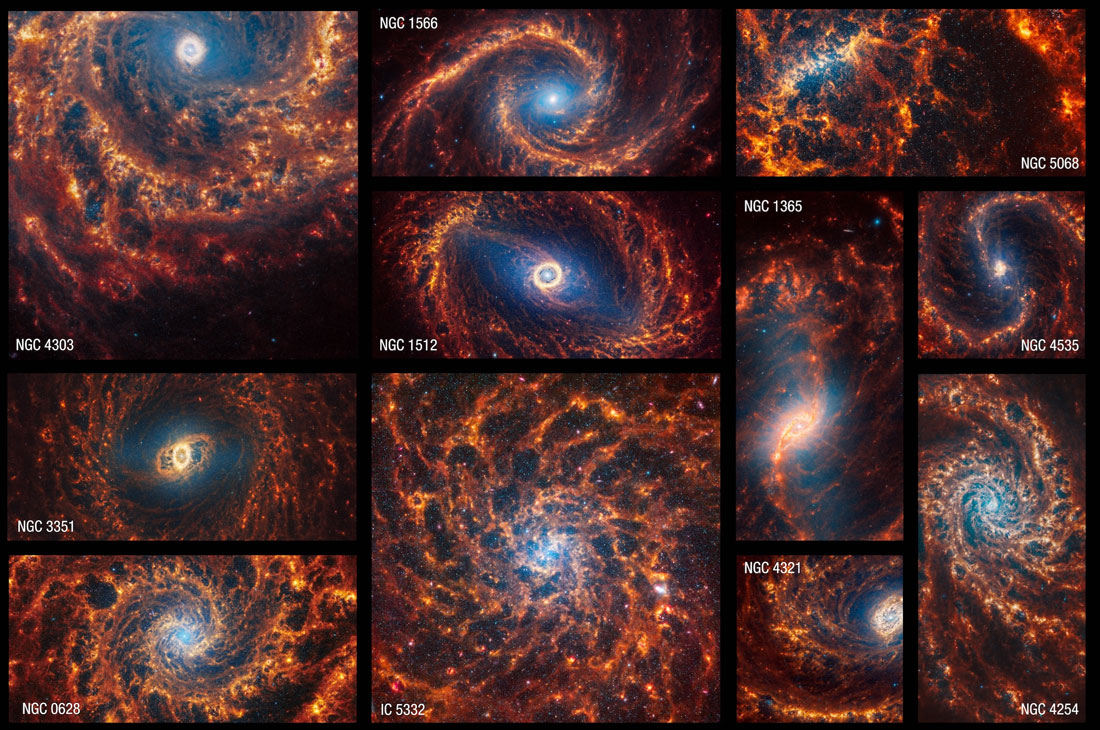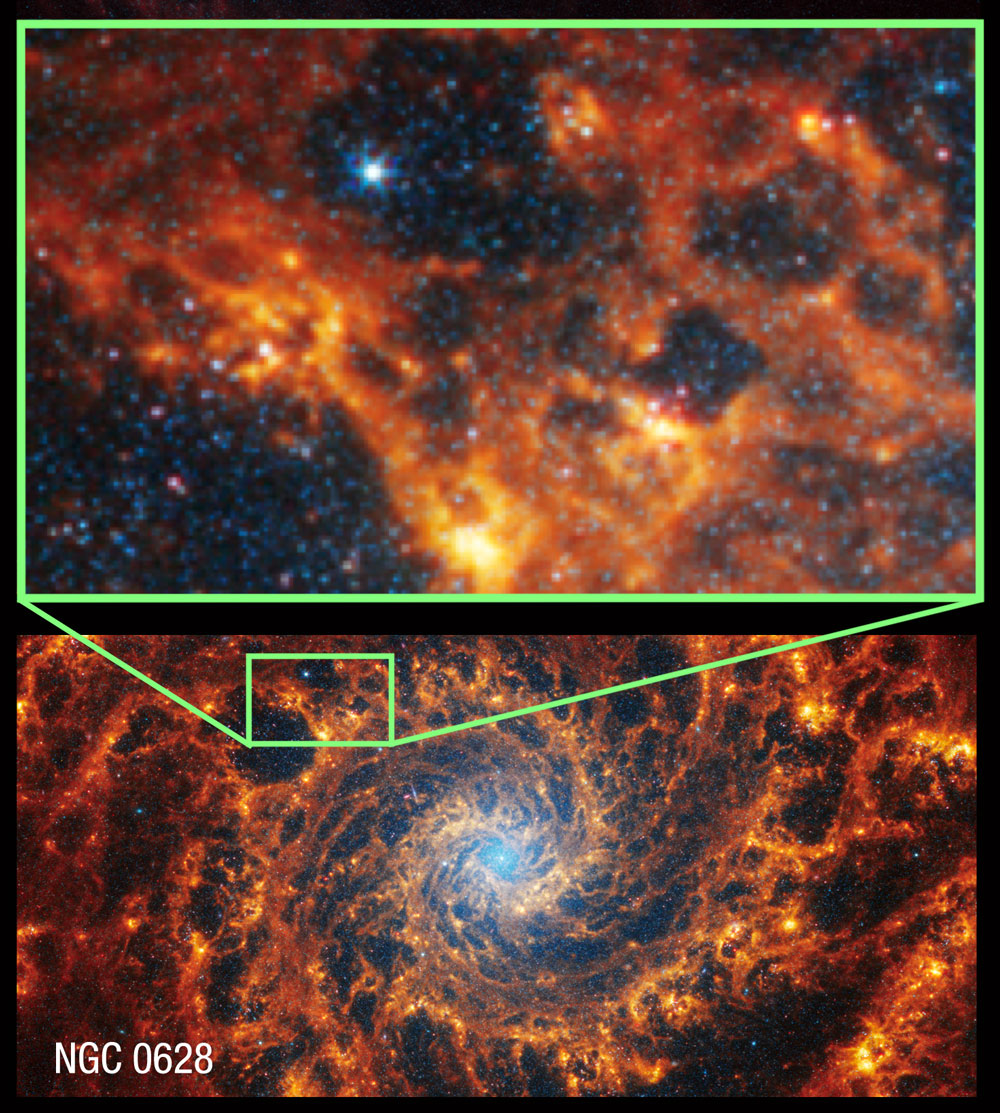Galactic dust reveals hidden patterns in stunning new images from James Webb
Using the James Webb Space Telescope, a team of researchers led by a Danish bachelor student has uncovered surprising new details about the fine structure of cosmic dust in nearby galaxies. This dust — tiny particles floating in space — plays a key role in how stars and planets are born, and how galaxies evolve. The new study shows that different kinds of dust clouds behave in very different ways, and even helps pinpoint the size of the smallest patterns that dust clouds naturally form inside galaxies.

We often think of galaxies as immense clumps of stars, slowly rotating in space. But stars only tell part of the story. Between them lies a rich mixture of gas and dust. Although this material may sound boring, it’s the fuel and building blocks for new stars and planets, and an important part of how galaxies change over time.
Utilizing the ultra-sharp vision of the James Webb Space Telescope, a team of researchers from the Cosmic Dawn Center at the Niels Bohr Institute looked closely at 13 nearby galaxies. Webb is able to detect infrared light — light our eyes can’t see, but which is perfect for spotting the faint glow of dust and large molecules floating in space.
“Different types of dust shine at different infrared wavelengths, depending on what they're made of and what’s happening around them,” says Charlie Lind-Thomsen, BSc student at the Cosmic Dawn Center and lead author of the new study. “We used four different kinds of infrared light to get a detailed view of how the dust is arranged.”
Using a technique known as “Fourier analysis” — a process with broad applications, e.g. in image and music compression — the team studied the patterns in the images, looking for repeating shapes and structures at different sizes.
Two types of dust, two different stories
One type of dust, made of large carbon-based molecules called “polycyclic aromatic hydrocarbons”, or PAHs for short (found here on Earth in car exhausts and barbecue smoke), lit up in smooth, widespread patterns — like fog lit by distant streetlights. These molecules tend to glow when they’re near young, hot stars, illuminating the dust with their ultraviolet light.

Zoom-in on the galaxy NGC 0628, revealing structure on both smal and large scales. Known also as the Phantom Galaxy, this beauty lies 32 million lightyears away in the constellation Pisces. Credit: NASA, ESA, CSA, STScI, J. Lee (STScI), T. Williams (Oxford), PHANGS Team, E. Wheatley (STScI).
In contrast, the more “normal” dust — tiny grains made of elements like silicates and carbon — looked clumpier and more uneven, as if it was concentrated in clouds around specific regions in the galaxies.
“Fourier analysis is a wonderful and versatile tool,” Lind-Thomsen enthuses. “It’s like zooming in and out on a photograph to see both the big picture and the fine details. Our analysis showed that these two kinds of dust don’t just glow differently — they’re structured differently too. Clouds of the larger dust grains form larger, more chaotic patterns, while clouds of carbon-based molecules show a much more even distribution.”
Even more intriguingly, the team found that the PAH clouds tend to disappear below a certain cloud size, roughly 500 lightyears across (about the distance from us to the star Betelgeuse).
“This suggests we’re seeing a kind of natural limit,” explains Lind-Thomsen. “The molecules stop glowing on smaller scales, either because they’re getting destroyed, or because the stars that light them up are more spread out.”
A new way to understand galaxies
The discovery helps astronomers better understand how galaxies work “beneath the surface.” It shows that different materials in galaxies — dust, gas, and stars — don’t just sit together randomly, but are organized in complex, scale-dependent ways.
By comparing these new results with future observations and computer models, the scientists hope to figure out how these dust patterns relate to things like star formation, galactic winds, and even the life cycle of matter in the Universe.
And the work is just beginning. Charlie Lind-Thomsen carried out his study under the supervision of Albert Sneppen, himself a Ph.D. student at the Cosmic Dawn Center.
“This is one of the first studies of its kind with James Webb,” says Albert Sneppen. “With more data, we’ll be able to learn even more about the hidden structures that shape our cosmos.”
The study has just been published in The Astrophysical Journal.
Contact
- Publication
- Lind-Thomsen et al., A Power Spectral Study of PHANGS Galaxies with JWST MIRI: On the Spatial Scales of Dust and Polycyclic Aromatic Hydrocarbons, https://doi.org/10.3847/1538-4357/adc808.
